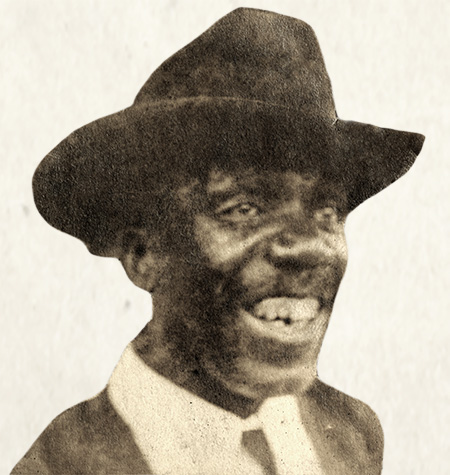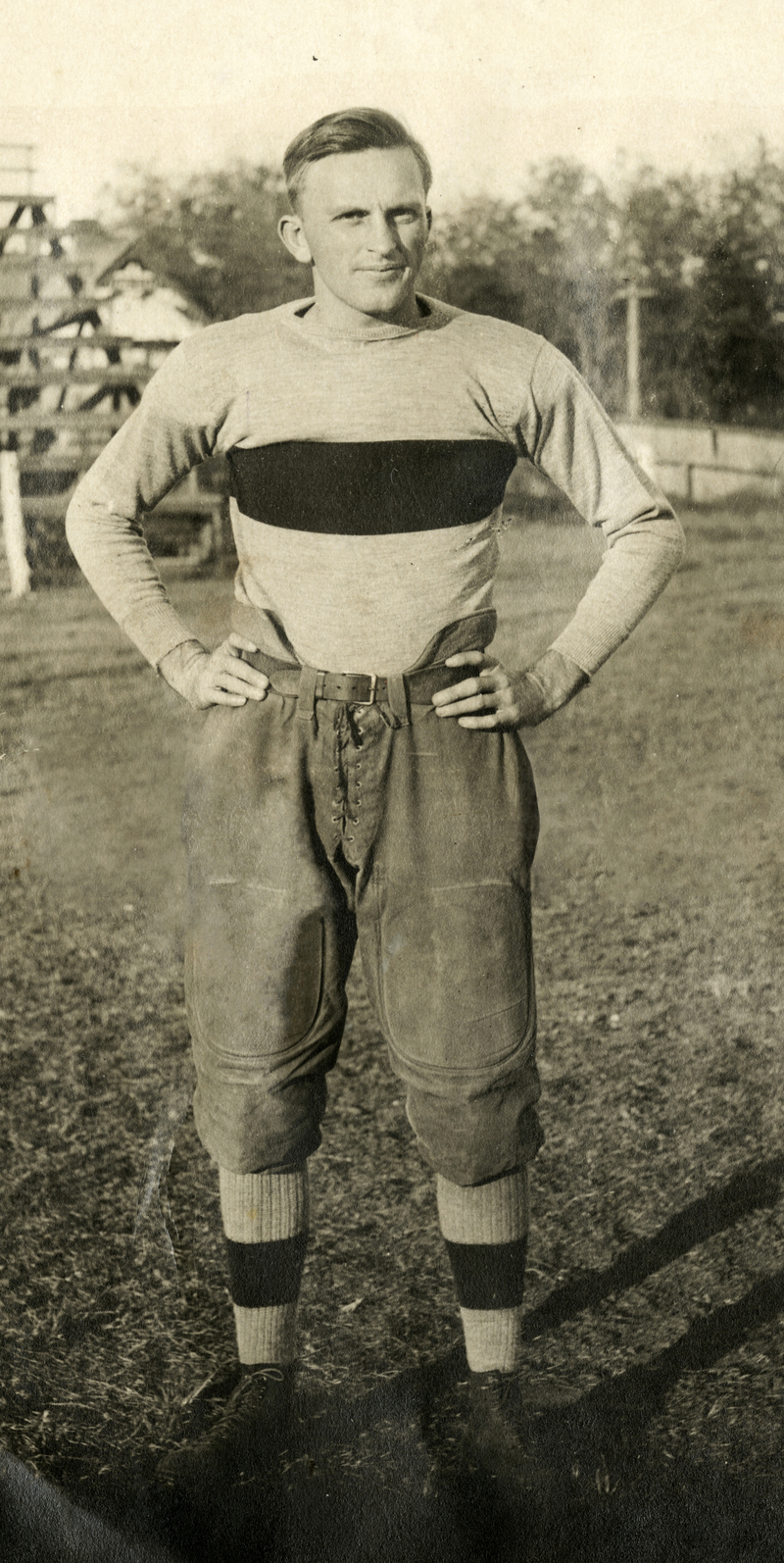In the fall of 1914, America had 48 states, Austin had 32,000 residents, and the University of Texas had 2,254 registered students. Theo Bellmont had joined the Athletic Department in 1913 as Director, bringing with him a small bulldog pup later to become known as Pig Bellmont—our unofficial mascot. There were virtually no cars on campus, we’d yet to graduate a Ph.D., and the early rumblings of war in Europe seemed far away from the Forty Acres. Although Austin’s first movie theater—the Crescent—had opened in 1913, student life and entertainment largely revolved around campus activities. At that time—even more than now—sports were the lifeblood of the University, and created a sense of pride and community. Ultimate UT booster Lutcher Stark provided special orange blankets for the team that year bearing the image of a Longhorn as well as the words “Texas Longhorns,” solidifying the team’s name. The 1915 yearbook—The Cactus—summed up the impact of the 1914 team thusly, “Characterized by far more than an unprecedented record of brilliant victories and its unequalled aggregate score, the undefeated 1914 football team will pass into history as the most eminently satisfactory and uniformly perfect team that ever bore the name of Longhorns.”
It’s been one hundred years since the men of that great team drove, and kicked, and threw the football on old Clark Field. However, as our new museum display at the Stark Center demonstrates, the legacy of that singular team and the men who played on it is worth remembering. For one thing, they didn’t just win—they crushed their opponents that season. Against strong schools like Oklahoma, Baylor, Rice, and Haskell—a football powerhouse in those early years—the Horns racked up 17 times more points than their opponents did, outscoring their opponents 358 to 21. Divided out over the eight games they played, the Horns averaged 44.75 points per game, a record that remained unbeaten by any other UT team until the 2005 National Championship team appeared . . . ninety-one years later. What’s more, one member of that team, Leonard “Len” Barrell, scored 14 touchdowns, kicked 34 extra points, and added a field goal for a season total of 121 points—a record that lasted until 1997, when it was broken by Heisman winner Ricky Williams. Barrell, a four-year letterman, played quarterback and halfback, and also punted and kicked for Texas.
Another factor that bears consideration in understanding the singular nature of this team’s amazing record is that the 1914 players, compared to modern major college footballers, were surprisingly small. Barrell, for example, played at 146 pounds, and the heaviest man on the team–center and team captain Louis Jordan–tipped the scales at only 205, and he was heavier by 25 pounds than any other player on the team. The increase in the size of collegiate players over the past century has been, well…enormous. Just how enormous—relative to 1914—can be seen by comparing the weights of the starting 1914 eleven to the starting twenty-two from the 2005 National Championship Team.
- Eleven starters on the 1914 team ranged from 146 lbs. to 205 lbs. and averaged 170.
- Eleven starting offensive players on the 2005 team ranged from 203 lbs. to 345 lbs. and averaged 277.
- Eleven starting defensive players on the 2005 team ranged from 200 lbs. to 315 lbs. and averaged 245.
The reasons for this change include the fact that 1) modern coaches no longer run any boy who “looks fat” until either the fat’s gone or the boy is, 2) the move away from men playing both offense and defense, 3) the escalating use, beginning in the 1960s, of progressive weight training, 4) the rise in the use of anabolic steroids and related substances, and 5) better nutrition and the spread of all-you-can-eat varsity dining halls and supplements high in protein. Also, these days coaches recruit Big and encourage Big.
Besides their small stature, however, the men on the 1914 team were notable in other ways as well. For example, seven of the men associated with that season would be inducted into the very exclusive Longhorn Hall of Honor: Clyde Littlefield, K.L. Berry, Len Barrell, Gus (Pig) Dittmar, James A “Pete” Edmond, Louis Jordan, Alva Carlton, Coach David Allerdice, Trainer and future baseball coach Billy Disch, and “Doc” Henry Reeves, the much-beloved African-American athletic trainer who provided medical care to the football players between 1895 and 1915. No other team in the history of the University has had so many men inducted. Although their Hall of Honor plaques on display in the exhibit provide a glimpse of the achievements of these men, what they fail to explain about them—and their teammates—is how well-rounded they were as students. Nearly all of them played at least one other sport, belonged to a fraternity, and most of them belonged to other campus organizations. Leonard (Len) Barrell, for example, also had starring roles in the University theater productions and, in 1915, was president of the campus-wide Thanksgiving Reception Committee. Louis Jordan, chosen an All-American by Walter Camp, was also the University’s best shot-putter and a member of the Engineering Honor Society. Gus Dittmar played basketball and served on the Student Council, James “Pete” Edmond belonged the prestigious Friar Society, and K.L Berry– who lettered in football, track, and wrestling—also served as Vice President of the UT Student Association before beginning his distinguished military career, during part of which he was a U.S. Army General.
From a sports perspective, the most important member of that great 1914 team was Clyde Littlefield, whose record as a Longhorn letterman and coach is unmatched. He earned 12 letters in three sports at The University—football,
basketball, and track-and-field—and if he’d had the time he would have been a baseball letterman as well. His phenomenal career from 1912 through 1916 coincided with one of the greatest eras in Texas sport. A two-time all-Southwest Conference selection in football, Littlefield played a variety of positions for the ‘Horns, including quarterback, and is credited as having helped popularize the forward pass in college football.
Littlefield also played on three unbeaten basketball teams, was high point man in basketball for two of those years, and earned All-American honors. In track, he never ran on a losing team, and his specialty was hurdling, in which he only lost one race and equaled the collegiate world record (15.2 seconds) in the 120-yard high hurdles. He also won two games for the Longhorn baseball team as a pitcher.
His greatest contribution came, however as a coach. As head football coach from 1927 through 1933, Littlefield won two SWC championships. However, he made a far greater contribution in track and field, where he coached for 43 years. During that time Littlefield’s teams won 25 Southwest Conference titles and featured 12 NCAA champions. In 1925, he co-founded the Texas Relays with Theo Bellmont, and developed the meet into one of the premier events in the sport. He was also a member of the coaching staff for team USA in the 1952 Olympic Games and served in many other capacities within the sport. To celebrate this legacy of excellence, Governor John Connally declared “Clyde Littlefield Day” in the State of Texas on April 2, 1963, to honor Littlefield’s many contributions to U.T. and to the greater world of sport outside the 40 acres.
The 1915 Cactus perhaps put it best when it wrote about the 1914 season: “The past season was perfect. We won, always won. Adversaries melted and spectators stood aghast. In the realm of football we were supreme. But underlying all of these decisive victories and gigantic scores was that most valuable characteristic of the memorable season—‘Texas Spirit.’”
Hook’ Em Horns,
Terry Todd






Leave a Reply